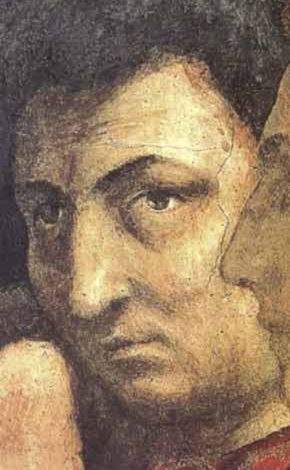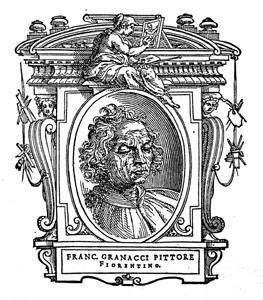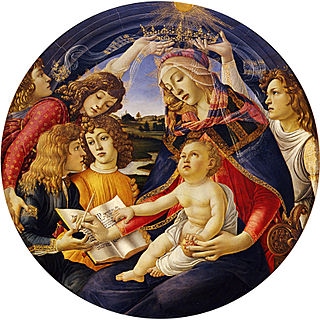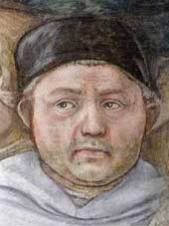
Masaccio, born Tommaso di Ser Giovanni di Simone, was a Florentine artist who is regarded as the first great Italian painter of the Quattrocento period of the Italian Renaissance. According to Vasari, Masaccio was the best painter of his generation because of his skill at imitating nature, recreating lifelike figures and movements as well as a convincing sense of three-dimensionality. He employed nudes and foreshortenings in his figures. This had seldom been done before him.

Alessandro di Mariano di Vanni Filipepi, better known as Sandro Botticelli or simply Botticelli, was an Italian painter of the Early Renaissance. Botticelli's posthumous reputation suffered until the late 19th century, when he was rediscovered by the Pre-Raphaelites who stimulated a reappraisal of his work. Since then, his paintings have been seen to represent the linear grace of late Italian Gothic and some Early Renaissance painting, even though they date from the latter half of the Italian Renaissance period.

Filippino Lippi was an Italian painter working in Florence, Italy during the later years of the Early Renaissance and first few years of the High Renaissance.

Andrea del Castagno or Andrea di Bartolo di Bargilla was an Italian Renaissance painter in Florence, influenced chiefly by Masaccio and Giotto di Bondone. His works include frescoes in Sant'Apollonia in Florence and the painted equestrian monument of Niccolò da Tolentino (1456) in Florence Cathedral. He in turn influenced the Ferrarese school of Cosmè Tura, Francesco del Cossa and Ercole de' Roberti.

Santa Maria Novella is a church in Florence, Italy, situated opposite, and lending its name to, the city's main railway station. Chronologically, it is the first great basilica in Florence, and is the city's principal Dominican church.

Filippo Lippi, also known as Lippo Lippi, was an Italian painter of the Quattrocento and a Carmelite priest. He was an early Renaissance master of a painting workshop, who taught many painters. Sandro Botticelli and Francesco di Pesello were among his most distinguished pupils. His son, Filippino Lippi, also studied under him and assisted in some late works.

Fra Diamante was an Italian Renaissance painter.

Lorenzo Lippi was an Italian painter and poet from Florence.

The Brancacci Chapel is a chapel in the Church of Santa Maria del Carmine in Florence, central Italy. It is sometimes called the "Sistine Chapel of the early Renaissance" for its painting cycle, among the most famous and influential of the period. Construction of the chapel was commissioned by Felice Brancacci and begun in 1422. The paintings were executed over the years 1425 to 1427. Public access is currently gained via the neighbouring convent, designed by Brunelleschi. The church and the chapel are treated as separate places to visit and as such have different opening times and it is quite difficult to see the rest of the church from the chapel.

Francesco Granacci was an Italian Renaissance painter active primarily in his native Florence. Though little-known today, he was regarded in his time and is featured in Giorgio Vasari's Lives of the Artists.

Florentine painting or the Florentine School refers to artists in, from, or influenced by the naturalistic style developed in Florence in the 14th century, largely through the efforts of Giotto di Bondone, and in the 15th century the leading school of Western painting. Some of the best known painters of the earlier Florentine School are Fra Angelico, Botticelli, Filippo Lippi, the Ghirlandaio family, Masolino, and Masaccio.
The decade of the 1460s in art involved some significant events.

This article about the development of themes in Italian Renaissance painting is an extension to the article Italian Renaissance painting, for which it provides additional pictures with commentary. The works encompassed are from Giotto in the early 14th century to Michelangelo's Last Judgement of the 1530s.

The Madonna of the Magnificat, is a painting of circular or tondo form by the Italian Renaissance painter Sandro Botticelli. It is also referred to as the Virgin and Child with Five Angels. In the tondo, we see the Virgin Mary writing the Magnificat with her right hand, with a pomegranate in her left, as two angels crown her with the Christ child on her lap. It is now in the galleries of the Uffizi, in Florence.

The historic centre of Florence is part of quartiere 1 of the Italian city of Florence. This quarter was named a World Heritage Site by UNESCO in 1982.

The Coronation of the Virgin is a painting of the Coronation of the Virgin by the Italian Renaissance master Filippo Lippi, in the Uffizi, Florence.

The Palazzo Pretorio is a historical building in Prato, Tuscany, Italy. It was the old city hall, standing in front of the current Palazzo Comunale. It now accommodates the Civic Museum of Prato, which was reopened in September 2013.

The Stories of St. Stephen and St. John the Baptist is a fresco cycle by the Italian Renaissance painter Filippo Lippi and his assistants, executed between 1452 and 1465. It is located in the Great Chapel of the Cathedral of Prato, Italy.

Lucrezia Buti was an Italian woman who became a Dominican novice and later, the lover of the painter Fra Filippo Lippi and the mother of their son and daughter. She is believed to be the model for several Madonnas featured in Lippi's paintings.

The Mystical Nativity or Adoration in the Forest was painted by Fra Filippo Lippi around 1459 as the altarpiece for the Magi Chapel in the new Palazzo Medici in Florence. It is now in the Gemäldegalerie, Berlin, with a copy by another artist now hanging in the chapel. It is a highly individual depiction of the familiar scene of the Nativity of Jesus in art, placed in a mountainous forest setting, with debris from woodcutting all around, rather than the familiar stable in Bethlehem, and with the usual figures and animals around the mother and child replaced by others.























